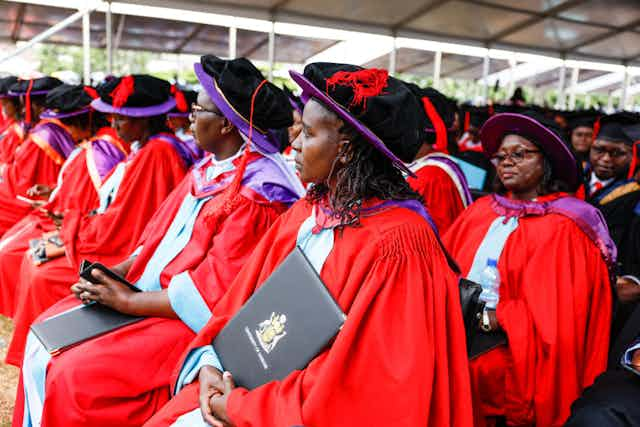A Kenyan vice-chancellor recently went public about the scarcity of university professors. There are fewer than 1,000 professors for the country’s 68 universities and 562,925 students. That is an average of around 563 students per professor. South Africa has around 4,034 professors and 1,112,439 students – around 275 students per professor.
Professors occupy the highest teaching rank in the university. They reach this rank by distinguishing themselves in teaching, research, scholarship and service. They should publish extensively in renowned journals, generate substantial research grants and conduct community engagement activities that make an impact.
In recent decades, a massive expansion of Kenya’s university system has occurred against a stagnant or declining professorial class. In 2010, for instance, Kenya had 32 universities with an enrolment of around 177,175 students. Today, the number of universities has more than doubled and enrolment has more than tripled. There were only 238 professors with an average of 774 students per professor. Thus, while enrolment in universities has surged by over 31%, the average number of student per professor has decreased by a similar amount (27%), suggesting a consistent pattern of low ratio of professors relative to student enrolments.
For public universities alone, government data indicates that the student population has surged by 70% while that of professors has grown by only 11% in the last 10 years. This dearth of professors has implications for academic leadership, knowledge generation, mentorship and university reputation in a competitive global academic environment.
My scholarly interest is in African higher education, with emphasis on finance, privatisation, marketisation, governance, equity and policy. In my view, the main reasons for the shortage of professors in Kenya are well documented. These are the low graduation of PhD degree holders, rapid expansion of the university system, heavy workload, absence of an institutional culture that supports academic scholarship, and departure of prominent academics from the universities.
To remedy the situation, universities could take three immediate actions:
fast track PhD graduation for academic staff on staff development programmes
reduce part-time academic staff in private universities
develop a government-supported national research programme that promotes rigorous scholarship.
Causes of professor shortage
One of the causes of the shortage of professors is rapid expansion of the university system. There are huge class sizes, sometimes 200-300 students in public universities. This means more time has to be spent on teaching and less on research to complete PhD studies or publish in journals.
The heavy workload and its impact on career progression has a gender dimension too. A study of three Kenyan universities documented the small number of female professors relative to male academics. Women’s career development is constrained by culturally defined domestic expectations coupled with university obligations.
Those joining the academic ranks after their PhDs soon discover that the universities lack a culture that nurtures and rewards rigorous research. A supportive institutional culture is missing even for established universities such as the University of Nairobi. Universities lack clear research goals, rigorous criteria for evaluating research, a student involvement strategy, budget guidelines, and incentives. This leads to lower research outcomes.
Several prominent professors have left universities to pursue careers in the public or private sectors or outside the country. Others have joined politics. The triggers of this migration from universities include poor pay and working conditions. Two other important triggers are the suppression of academic freedom and general decline in intellectualism in the universities.
Impact of scarcity
As the professor class has shrunk, so has the number of PhD graduates. Kenya should produce 2,400 PhDs every year to meet demand but is only able to produce 230.
The scarcity of professors translates into lower institutional reputation. Professors exercise leadership in research, publications, partnerships and grant developments, the key attributes of university reputation.
As measured by reputable index peer-reviewed journals, Kenya ranks in the lower quartile. In the global 2023 Scimago Institutional Rankings, the University of Nairobi and Kenyatta University, the top universities in Kenya, were ranked 5,065 and 5,231 respectively.
Without a robust reputation, Kenya’s universities encounter challenges attracting competitive research grants, international partnerships and linkages, and international students and faculty.
The way forward
The first step to boost professor numbers is for universities to accelerate the graduation of PhD candidates – especially those destined to join the staff. They should have time to do research and write their theses. After graduating, they would join the teaching ranks and collaborate with professors in research, preparing them for professorship.
Kenya’s private universities employ high numbers of part-time lecturers because they are cost-effective. But this should be limited. Part-timers rarely supervise doctoral students or engage in scholarship and community service. Therefore, they stand little chance of being appointed to the rank of professor.
According to one 2017 study in a private university, 80% of students were taught by part-timers.
Universities, with the support of the government, should develop an environment that promotes rigorous research and scholarship. They should enact policies on sabbatical leave and incentives for securing research grants and publishing in reputable journals. They should have predictable criteria for promotion to professorship.
Kenya can consider the example of South Africa’s top universities. With the support of the government, they developed precise models for research, publications, rewards and promotion that allow universities to maintain their international standings. This transformation has also sought to address the inequities created by the racist apartheid policies of the past.

